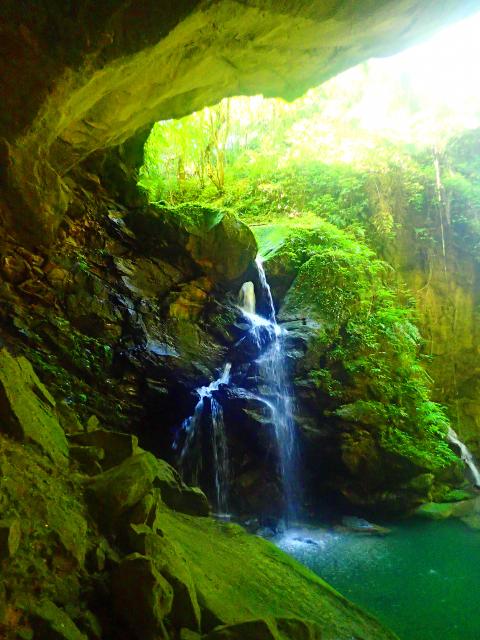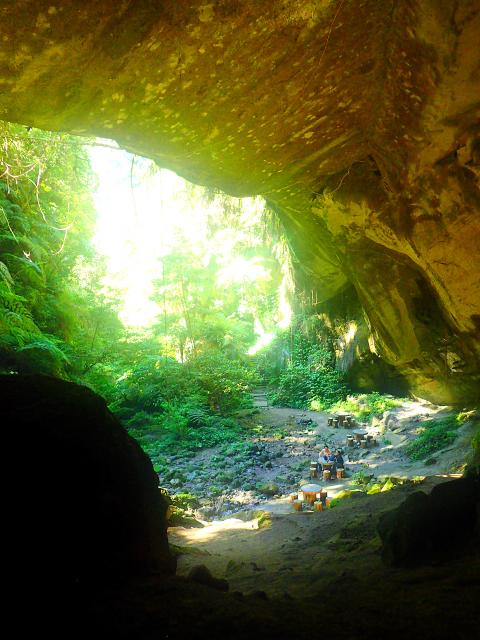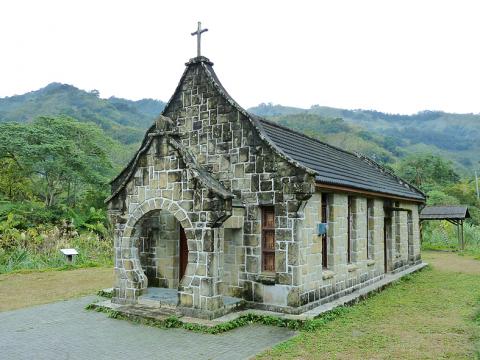It’s hard to believe that Sanmin Bat Cave (三民蝙蝠洞), hidden in the wooded hills off the North Cross-island Highway in Taoyuan City, was only “discovered” in 1923. The cave, 50-meters long, 30-meters in height and 20-meters in depth, is one of Taiwan’s largest. In fact, as far as I know only the Thousand People Cave (千人洞), hidden in a far more remote location high in the rugged mountains of Chiayi County, is bigger.
These days the Bat Cave is one of Taoyuan’s better-known natural wonders, so it’s surprising, perhaps, that until about a decade ago getting to the cave was a bit of an expedition.
Then, as now, a trip to this mysterious, yawning overhang in a rocky cliff (like most examples in Taiwan, it’s not really a true cave) started by following the first few kilometers of the North Cross-island Highway (Highway 7) from the town of Dasi (大溪) to the smaller settlement of Sanmin (三民). The highway forms the main street of this little village, which seems to have been trapped in a time warp, and, unlike nearly Fusing (復興), has changed little in decades.

Photo: Richard Saunders
Immediately after crossing a bridge over a stream in the middle of the village, turn left down a signposted lane, passing a church (a reminder that this is Aboriginal country — the Atayal people live in the area).
In exactly three kilometers, the road ends at a parking area: the trailhead for the Bat Cave. Four hundred meters before the car park, a short detour down a road on the left leads to Jiguopai Old Church (基國派老教堂), a small stone chapel, standing in a grassy field and looking for all the world as though it were airlifted in from somewhere in northern Europe. It’s become quite famous in recent years, and attracts a steady stream of visitors.
Until the authorities greatly improved access to the Bat Cave about a decade ago, this was where the fun started, as a narrow track infested with head-high silver grass connected with the top of a fixed rope, an essential aid for negotiating a long, steep and slippery rock face, and getting safely down to the bottom of the gorge below the Bat Cave.

Photo: Richard Saunders
Safely at the bottom, visitors next faced a short but slippery river trace upstream. A large rock, which blocks further progress, required scaling another fixed rope, and a little further upstream the huge mouth of the cave finally loomed in front.
This short but exciting adventure was one of the highlights of a visit to Sanmin Bat Cave, so it’s sad to say the route is no more. Local authorities have created a new route, cutting a stepped path down into the gorge and engineering a wide trail, high and dry above the stream, up to the cave. The resulting experience is less memorable, but it’s still a fascinating and atmospheric place, especially during weekdays (it can get busy on weekend afternoons).
A wooden arch beside the parking area at the end of the road marks the beginning of the new path — a wide, brick-paved track, studded at intervals with tiles painted with spooky black bats. It’s a short uphill climb to a junction next to a small viewing tower. Take the left fork here, and stone steps descend gently into the wooded depths of the gorge just below the Bat Cave. Cross the stream and follow the wide, surfaced path for a minute or two. Climb a series of steps around a large boulder, and the Bat Cave itself suddenly comes impressively into view.

Photo: Richard Saunders
The great overhang lies in a beautiful, sylvan glen hung with ferns and grass, echoing with the sound of a small waterfall which pours into the ravine beside the cave. It’s an impressive sight, even though the bats that once called it home have long-since been scared off by the increasing number of visitors. Try to arrive around the middle of the day, when the sunlight briefly streams into the usually gloomy gorge.
Beside the great overhang lies a smaller but fascinating natural curiosity. The 15-meter-high waterfall that plunges into the gorge beside the cave has worn a small but beautifully formed natural hole through the solid rock. If you follow the brick road straight ahead at the junction next to the viewing tower above the Bat Cave, it soon ends at a dirt path that leads to a second natural cave a couple of kilometers (40 minutes’ walk) to the east: Guanyin Cave (觀音洞). Look out on the left just after the beginning for a side trail that leads down to the brink of the waterfall beside the Bat Cave for an unusual view over it (but beware the very slippery mossy rocks in the streambed).
For years, the path to Guanyin Cave was spared the excesses of the well-meaning but sometimes ecologically insensitive local authorities, and was a beautiful short walk beside two mossy streams, passing a pretty waterfall. Unfortunately, work began last month on “improving” the path, and the natural beauty of the trail is already being compromised. At the end is a gate on the edge of the compound of the large temple built in front of Guanyin Cave. The huge temple building itself is functional rather than decorative, but behind it, dominating the view and visible for miles around, is a huge, gleaming gold statue of the seated Guanyin, which is an impressive sight.
Richard Saunders is a classical pianist and writer who has lived in Taiwan since 1993. He’s the founder of a local hiking group, Taipei Hikers, and is the author of six books about Taiwan, including Taiwan 101 and Taipei Escapes. Visit his Web site at www.taiwanoffthebeatentrack.com.

On April 26, The Lancet published a letter from two doctors at Taichung-based China Medical University Hospital (CMUH) warning that “Taiwan’s Health Care System is on the Brink of Collapse.” The authors said that “Years of policy inaction and mismanagement of resources have led to the National Health Insurance system operating under unsustainable conditions.” The pushback was immediate. Errors in the paper were quickly identified and publicized, to discredit the authors (the hospital apologized). CNA reported that CMUH said the letter described Taiwan in 2021 as having 62 nurses per 10,000 people, when the correct number was 78 nurses per 10,000

As we live longer, our risk of cognitive impairment is increasing. How can we delay the onset of symptoms? Do we have to give up every indulgence or can small changes make a difference? We asked neurologists for tips on how to keep our brains healthy for life. TAKE CARE OF YOUR HEALTH “All of the sensible things that apply to bodily health apply to brain health,” says Suzanne O’Sullivan, a consultant in neurology at the National Hospital for Neurology and Neurosurgery in London, and the author of The Age of Diagnosis. “When you’re 20, you can get away with absolute

May 5 to May 11 What started out as friction between Taiwanese students at Taichung First High School and a Japanese head cook escalated dramatically over the first two weeks of May 1927. It began on April 30 when the cook’s wife knew that lotus starch used in that night’s dinner had rat feces in it, but failed to inform staff until the meal was already prepared. The students believed that her silence was intentional, and filed a complaint. The school’s Japanese administrators sided with the cook’s family, dismissing the students as troublemakers and clamping down on their freedoms — with

As Donald Trump’s executive order in March led to the shuttering of Voice of America (VOA) — the global broadcaster whose roots date back to the fight against Nazi propaganda — he quickly attracted support from figures not used to aligning themselves with any US administration. Trump had ordered the US Agency for Global Media, the federal agency that funds VOA and other groups promoting independent journalism overseas, to be “eliminated to the maximum extent consistent with applicable law.” The decision suddenly halted programming in 49 languages to more than 425 million people. In Moscow, Margarita Simonyan, the hardline editor-in-chief of the